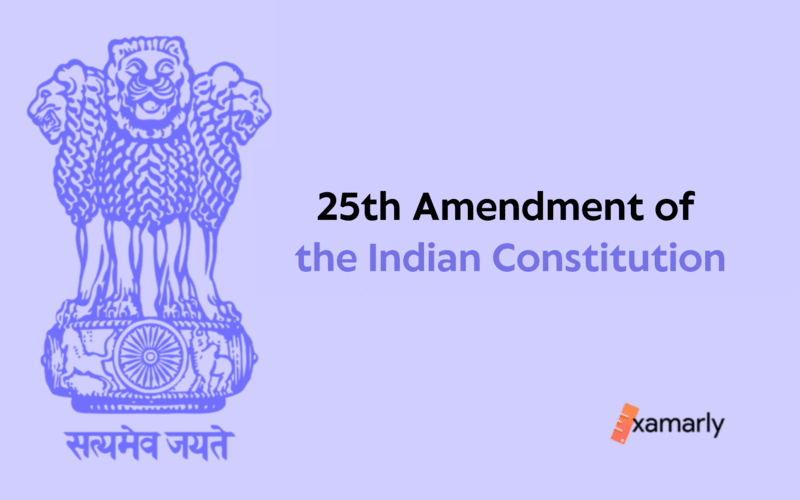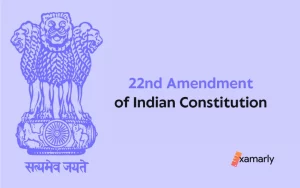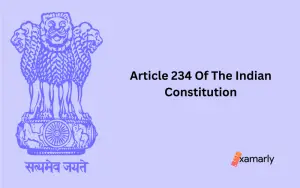The purpose of the 25th Amendment of the Indian Constitution was to eliminate the Supreme Court’s discretion over the amount of compensation paid when private property is taken for public use.
Even though a law infringed fundamental rights, it was excluded from judicial scrutiny if it gave effect to articles 39(b) and (c) of the Directive Principles of State Policy.
This article will provide you with some background information on the 25th amendment of the Indian Constitution.
Find out what prompted this change, what was the purpose of the Amendment, and what changes were made by it.
Background
The Supreme Court, in 1970, ruled in the case recognized as the case of Bank Nationalization, Rustom Cavasjee Cooper v. Union of India, that the Constitution provides compensation rights or the economic equality of the property that was forcibly acquired.
The Court further ruled that Article 19(1)(f) must be met by any statute that aims to requisition or buy property for public purposes, from the property owner.
The Supreme Court decision’s limitations on the government were intended to be overturned by the 25th Amendment.
Article 31 used to declare that no law involving forced property acquisition or maybe requisitioning, which either fixes or specifies how the compensation is decided and delivered, may be challenged in court because the compensation it offers is insufficient.
The 25th Amendment of the Indian Constitution has restored Parliament’s ability to change, the basic rights known as the Fundamental Rights.
This made it possible for the Indian government to change Article 31, which deals with property rights.
The Supreme Court’s ability to determine the amount of compensation escaped. The confiscation of the land of landowners for public necessities was to be taken away by the 25th Amendment.
The amendment would fulfil it by changing the word “compensation” for the property or loss of property. It became “amount”.
The Article 31 amendment would also add a new clause 31(C) to the Constitution. It would deny a bill from being questioned in court under Articles 14 (equality in front of the law), 19 (right to property, freedom of organization, speech, and religion, etc.), or 31 (on lack of law besides under the authority of law) if Parliament licensed that the bill was planned to provide fair dispersal of material aids or to prevent concentration of financial power.
In October 1971, the Law Commission was guided by former Supreme Court Chief Justice P.B. Gajendragadkar. He suggested the omission of part of article 31C.
It established any law including a statement that it was for providing results to certain Directive Principles, beyond judicial review.
The Commission said that it would be “unreasonable” to prevent any judicial inquisition into the question.
It was about whether laws enacted in pursuance of the approach (giving preeminence to Directive Principles) bore any association with the objects intended to be fitted by it.
Parliament should entrust the judiciary to do its assignment, valiantly, impartially, and objectively.
To carry cognizance of the changed mindset that Parliament offered to embrace in acknowledging the significance, urgency, and importance of enforcing the Directive Principles in question. However, the notice was abandoned by the government.
The Law Commission’s view would be explained in 1973. It would be executed by the Supreme Court judgment in K. Bharti vs the state of Kerala. In that case, the Court held the appropriate unit of the 25th Amendment unconstitutional.
25th Amendment of the Indian Constitution and its causes
The Constitution (Twenty-Fifth Amendment) Act, 1971 was passed by Parliament in the twenty-second year of the Republic of India.
It was done on 20 April 1972. This aimed to reverse the Supreme Court’s ruling in R.C. Cooper vs Union of India (1970).
It is also popularly known as the bank nationalization case. It focused on the amendment of Article 31 and introduced a new Article 31C.
Thus effectively preventing citizens from challenging laws relating to the acquisition of property.
Article 31 provided for a fundamental property right. It stated major terms about any person whose property was acquired by the Government.
It meant that they were entitled to compensation. Since 1954, the Supreme Court consistently held that under the requirements of Article 31.
If the Government acquired the property of landowners, it had to pay adequate compensation equivalent to its market value. Parliament responded by passing the Constitution (Fourth Amendment) Act 1955.
It prohibited people from challenging their requisitioning of property on the grounds of inadequate compensation for the loss. The Court retained its post, irrespectively.
In 1969, the Indira Gandhi Government decided to nationalize 14 private banks. Further passed legislation to this effect.
A famous case example is that of R.C. Cooper V. Union of India. Rustom Cavasjee Cooper is a shareholder in one of these banks.
He challenged this legislation before the Supreme Court. He argued against the legislation for not giving him the adequacy of compensation.
Therefore violating his fundamental right to property under Article 31, and freedom to carry on a business under Article 19(1)(g).
The Court agreed with Cooper. And passed a judgment striking down the relevant portion of the legislation.
This activated Parliament to pass the 25th Amendment. It capsizes the decision in R.C. Cooper.
The 25th Amendment of the Indian Constitution brought the replacement of a term. The word ‘compensation’ in Article 31(2) was superseded with ‘amount’.
This could be resolved by law. This suggested that if the government took property away from residents, there might be a miniature fee applied. The Amendment outlawed any challenge against this ‘amount’.
Finally, it noted that the purchase of the property would supersede the fundamental right. I ensured to carry on a business or trade under Article 19(1)(g).
Therefore, any acquisition could not be contested exclusively because it disregards this right. The 25th Constitutional Amendment was designed to deprive the Supreme Court of power.
It was not allowed to choose the portion of compensation for a takeover of property for public use.
The Amendment also inserted Article 31C. This Article remarked that any regulation which was passed to enforce the objectives under Article 39B and C – which are Directive Principles of State Policy.
DPSPs could not be inquired about or examined by the Court for infringing fundamental rights.
This was an example of the tussle between the Court and Parliament. It was established on the constitutional significance of and the connection between fundamental rights and DPSPs.
The 44th Amendment resulted in the elision of property right. Though it was one of the fundamental liberties.
Rather, it became a constitutional privilege under Article 300A. But it does not say the quantum of compensation.
Before the 25th Amendment was enacted, the succession rules were vague and disjointed. It was often unclear who would follow the President.
In the affair of vacuity in the office, the vice president would be selected to fulfil the role.
Provisions of the 25th Amendment
The 25th Amendment Act of 1971 has two provisions:
- Shrunk the fundamental property right.
- Any law constructed to cause the Directive Principle included in Article 39 (b) or (c), cannot be contested. It can’t be questioned on the grounds of disregarding the rights guaranteed under Articles 14, 19, and 31.
Scenario Before the 25th Amendment Act
Before the insertion of Article 31C by the 25th Amendment Act, the Courts had typically held Fundamental Rights more ultimately.
This matter was determined by the Supreme Court in the State of Madras v. Champakam Dorairajan, where a state order in battle with Article 29(2), a Fundamental Right, was displayed as invalid, although the government took the defence that it was made in pursuance of Article 46, a Directive Principle.
But the Courts also adopted a view that in determining the scope and ambit of Fundamental Rights.
The Directive Principles should not be completely ignored, and the Courts should adopt a principle of harmonious construction ànd attempt to give effect to both as far as possible.
For instance, in the Kerala Education Bill from 1958. C.J. Das pleaded for a healthy balance between the two while stating that Fundamental Rights came first over Directive Principles.
Judicial View on the 25th CAA
The constitutional fact of the 25th amendment was being examined. A group of judges who have voiced their doubts about the Constitution’s facts is reliable.
These judges have displayed that the amendment’s first half should be kept and the rest should be invalidated.
The decision of the bench consists of seven judges and two women, with the conclusion being 7:6 in favour of the first half and 5 against it.
The first section of the 25th Amendment Act, known as Article 31C, gives importance to Fundamental Rights.
In other words, the 25th Amendment Act changes the proportion. The altered consonance was between Fundamental Rights and Directive Principles of State Policy.
By allocating preference to the latter, the amendment adjusts the balance of power between the two.
Therefore, the Court invalidates the second part of the amendment. However, it keeps the first part of the amendment if it is subjected to certain circumstances.
With historic rulings, the judiciary took integral actions to revive the absolute framework of the Indian Constitution.
The petitioners’ primary dispute is that the 25th amendment was conveyed to reinforce the power of Indira Gandhi’s government.
They contend that the amendment violates their fundamental liberties to own property and to bear on a business.
The Supreme Court settled with them and invalidated the appropriate portion of the legislation. This conclusion led Parliament to pass the 25th Amendment.
Aftermath of 25th CAA
In 1971, the Indian Constitution was amended by the Twenty-Fifth Amendment Act. It desired to change the legal framework covering the compulsory acquisition of private property.
The revision amended Article 31 to restrict citizens from questioning laws. Hence controlling the requisition of property by the government. The shift was fitted by many, but it was met with intense criticism in many quarters.
The Supreme Court chose that compensation in article 31(2) must be “just equivalent” in money, which is a provision of Article 19(1)(f).
The Court maintained that the compensation must satisfy the conditions laid down in Article 19(1)(f).
The decision had a wide-reaching effect on the compensation. It can be paid for property obtained under a law that benefits the article’s requirements.
Kesavananda Bharati Case
A vital analysis of this modification was made in the mammoth decision of the Kesavananda Bharati Case.
There Article 31-C’s first half was displayed as valid by seven justices (Ray, Palekar, Khanna, Mathew, Beg, Dwivedi, and Chandrachud, JJ), invalid by five (Sikri, CJ, Shelat, Grover, Hegde, and Mukherjea, JJ); and valid upon severance by Jaganmohan Reddy.
Article 31C possessed the following clause:
“And no law including a proclamation that it is for conveying result to such policy shall be anointed in the query in any court on the ground that it does not give outcome to such policy”.
These words, forming the second part of Art 31C, aimed to expel the jurisdiction of the courts. It finds out whether the law for the security of which Art 31C was invoked. It gave the product to the regulations in Article 39(b) or (c).
But this claim has been held feeble by the number of judges in the Keshwananda Bharati case. It was on the ground that judicial review is the basic feature of the Constitution of India, which cannot be accomplished away with by the revision under Article 368.
Conclusion
In the Kesavananda Bharati judgment, the 25 Amendment of the Indian Constitution accepted gruelling criticism.
It was especially the unit concerning the ouster of jurisdiction. The basic structural concept, which was based on the same case, was regarded as being disregarded by the Parliament’s obvious attempt to intrude on the power of the judiciary.
The 25th Constitutional Amendment intended to deprive the Supreme Court of an ability. It took away the government’s ability to select the portion of compensation for taking over property for public use.
The 25th amendment was planned to act as a trigger in the process of supporting Indira Gandhi’s role.
And unfolding the one-party system that had been launched with the 24th amendment. The Indian judiciary’s position was later drained. And the control of the parliament was improved, as a result of further changes.
FAQs on the 25th Amendment of the Indian Constitution
What is the 25th Constitutional Amendment in India?
The Twenty-fifth Amendment was enacted as a solution to the ongoing issues surrounding the office of the President. The issue was about what procedures should be followed if the President becomes so handicapped that he is unable to perform his duties.
When was the 25th Amendment Passed?
The Constitution (Twenty-Fifth Amendment) Act 1971 was passed by Parliament. It was accomplished on 20 April in the year 1972. This strived to backfire on the Supreme Court’s decree in R.C. Cooper vs Union of India (1970).
Who Introduced It?
The 25th Amendment to the Indian Constitution was introduced by H.R. Gokhale.
Which Articles of the Indian Constitution are related to the 25th Amendment of the Indian Constitution?
Article 19, Article 31, Article 39, Article 29 and Article 14 are related to the 25th Amendment of the Indian Constitution.
What did Article 31 of the Indian Constitution declare?
Article 31 provided for a fundamental property right. It stated major terms about any person whose property was acquired by the Government.






